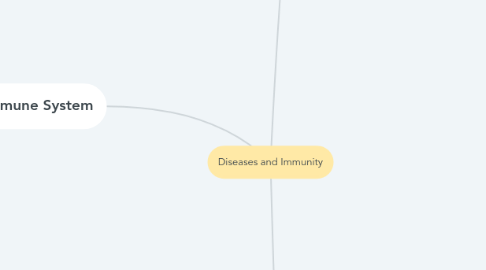
1. Immune System
1.1. Vaccinations
1.1.1. contains weakened or dead viruses and bacteria with same antigen but unable to cause disease
1.1.2. recognized by lymphocytes that can make antibodies to lock in their antigens, making memory cells to remember the infection
1.1.3. some require 2 doses - second dose is generally a booster to stimulate the lymphocytes to make more antibodies and memory cells
1.1.4. the control of many other serious infectious diseases relies on vaccination of children - also known as 'herd immunity'
1.2. Active and Passive
1.2.1. Active
1.2.1.1. made their own antibodies and memory cells to protect
1.2.1.2. causes by having the disease prior or by vaccinations
1.2.1.3. long term
1.2.2. Passive
1.2.2.1. have been given antibodies made by other organisms
1.2.2.2. babies get passive through breast feeding as their immune system can not yet fight off diseases
1.2.2.2.1. Colostrum (first yellow milk of mother - rich in antibodies) after birth
1.2.2.3. injecting with antibodies made by other can destroy the pathogen, while waiting for the body to make it's own could take too long
1.2.2.4. short term as antibodies will eventually be broken down, and no lymphocyte has been stimulated to make memory cells
1.3. Innate and Acquired
1.3.1. Innate
1.3.1.1. born with physiological barriers
1.3.1.2. first line of defense in your immune response
1.3.2. Acquired
1.3.2.1. after exposure to antigen
1.3.2.2. white blood cells
1.3.2.2.1. Lymphocytes
1.3.2.2.2. Phagocytes
1.3.2.3. dendritic cells
1.3.2.4. cytokines
1.4. Covid - 19 or Severe Acute Respiratory Syndrome Coronvirus 2
1.4.1. structure : spherical viruses with protein spikes sticking out to help it attach to human cells
1.4.2. very easily transmittable and can stay on surfaces for several days
1.4.3. can be transmitted from people with no symptoms - 'carriers'
1.4.4. can cause difficulty in breathing for some
1.4.5. Precautions : people asked to stay home and isolated for 14 days if positive, tests conducted all over country, wearing masks
2. Entry of Pathogens (Infection)
2.1. Direct Contact (contagious diseases)
2.1.1. pathogen transferring through contact
2.1.2. HIV can be transmitted when an infected person's body fluids come into contact with another person's
2.1.3. Fungus, athlete's foot, can be passed on by using towel
2.2. Indirect Transmission
2.2.1. airborne - breathing in droplets containing pathogens
2.2.2. formit borne - touching a surface with someone with the pathogen has touched
2.2.3. eating food or drinking water that contains pathogens (eg. - Salmonella, Cholera)
2.2.4. contact with animals containing pathogens
2.2.4.1. Vectors
2.2.4.1.1. carries pathogen from one host to another
2.2.4.1.2. eg. - dogs, skunks and bats are vectors for rabies (through saliva when they bite)
2.2.4.1.3. Malaria - plasmodium is in female anopheles which bite, the infection in the blood stream causes rbc to rupture and indirectly affects hemoglobin levels
2.3. Body Defences (Innate)
2.3.1. hair in nose filter out particles that could contain pathogens
2.3.2. skin prevents entry as outer layer is dead cells with keratin which is hard to penetrate, blood clot is formed if skin is torn to avoid entry of pathogens
2.3.3. mucus in airway traps bacteria, cilia sweeping it to the back of the throat and swallowed to prevent getting to lungs
2.3.4. hydrochloric acid in the stomach kills bacteria in our food
2.3.5. tears prevent microbial growth making a barrier (slightly alkaline)
2.3.6. saliva (slightly alkaline) contains the antibody IgA that lines your oral cavity and helps kill bacteria
2.4. Cholera
2.4.1. can be spread through water and food which have been contaminated with feces from an infected person
2.4.2. Pathway
2.4.2.1. 1. cholera bacteria are ingested and multiply
2.4.2.2. 2. the bacteria attach to the wall of the alimentary canal
2.4.2.3. 3. the bacteria releases toxin
2.4.2.4. 4. chloride ions to be releases
2.4.2.5. 5. the release of ions causes water to move into the lumen by osmosis
2.4.2.6. 6. alot of water in the canal (watery diarrohoea), blood contains too little chloride ions and water
2.4.3. Treatment
2.4.3.1. hydration using drinks containing glucose, water, and salt
2.5. Bacteria
2.5.1. thermophiles - high temp
2.5.2. acidophiles - acidic pH (body pH 5.5)
2.5.3. opportunistic bacteria - inside your body but help unlike when immune system is compromised (eg - E.coli)
2.5.4. Amoeba
3. Prevention
3.1. Clean Water Supply
3.1.1. before entering the pipes, water is filtered to remove dirt and then treated with chlorine to kill microorganisms
3.2. Food Hygiene
3.2.1. keep meat away before cooking as pathogens can be spread
3.2.2. keeping in the freezer (below 1c) in the most affective but fridge (13 to 15c) helps prevent growth of most bacteria as well (not all)
3.2.3. don't keep food at room temperature as bacteria grows best between 10 to 48 degree celsius
3.2.4. keeps animals away as they are more likely to carry harmful pathogens, eg. - houseflies
3.3. Personal Hygiene
3.3.1. human skin makes an oil to keep it supple and waterproof, oil can build up with dirt and pathogens if not washed
3.3.2. sweat helps maintain body temp but can also be the breeding ground for bacteria if not washed, causes unpleasant smell
3.3.3. some bacteria in the mouth can cause bad breath and tooth decay
3.4. Water Disposal
3.4.1. bacteria breed in food waste where animals such as flies are also present
3.4.2. dangerous chemicals seep out pollution ground and waterways
3.5. Sterilization
3.5.1. an autoclave is a machine that uses steam under pressure to kill harmful bacteria, viruses, fungi, and spores on items that are placed inside a pressure vessel.
